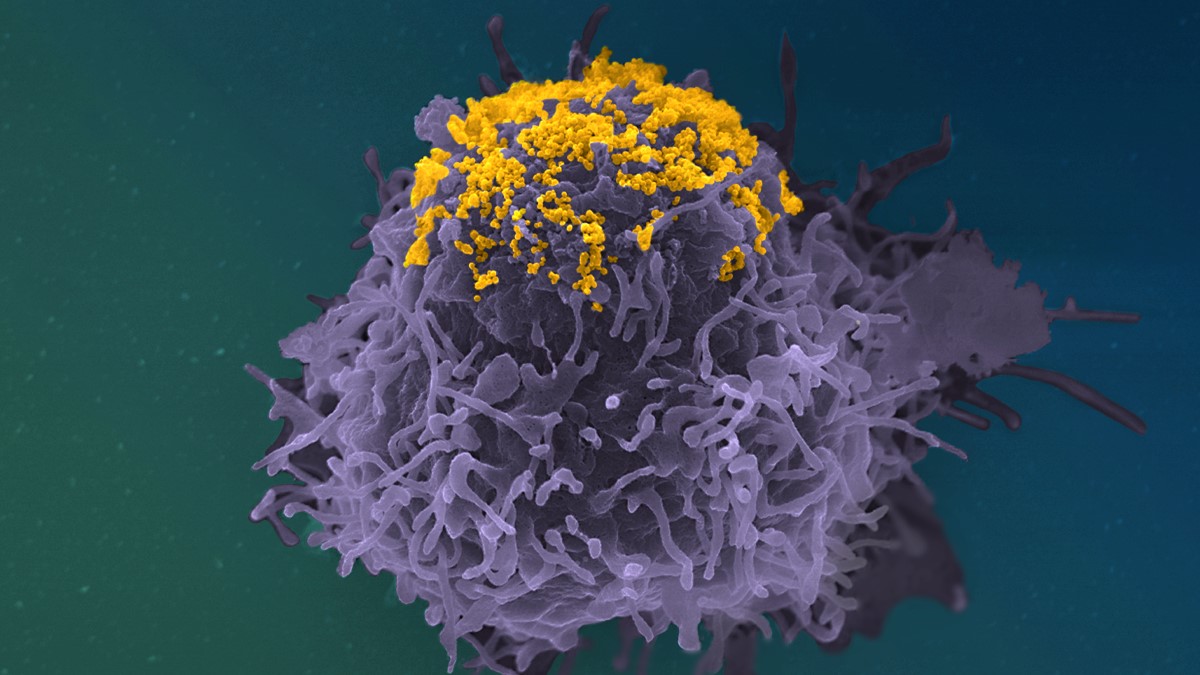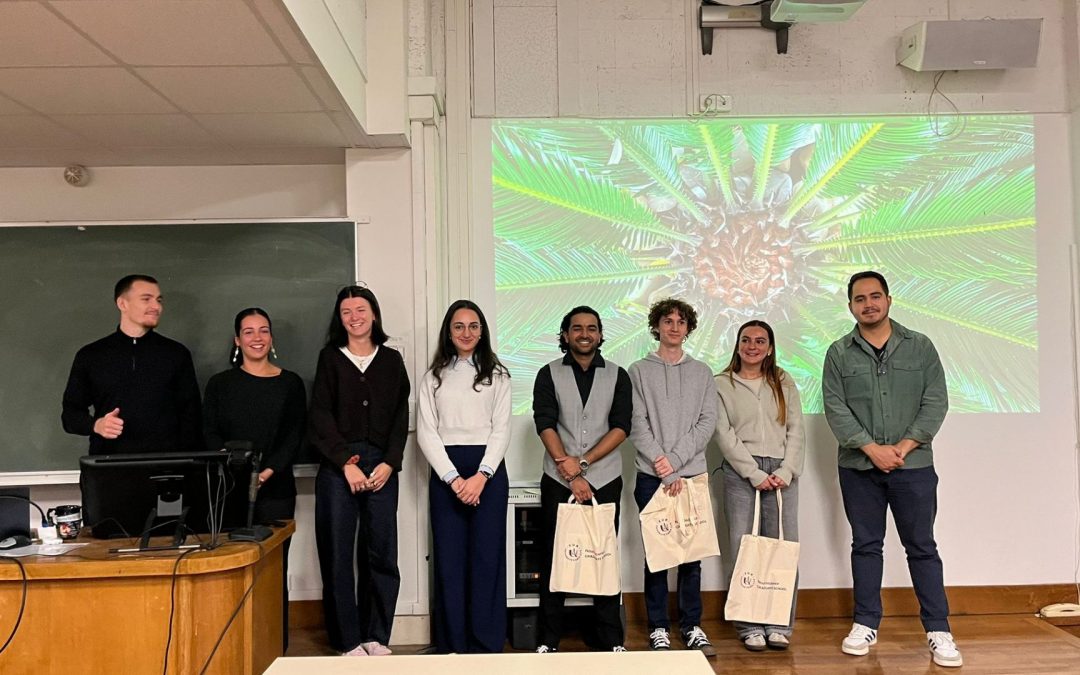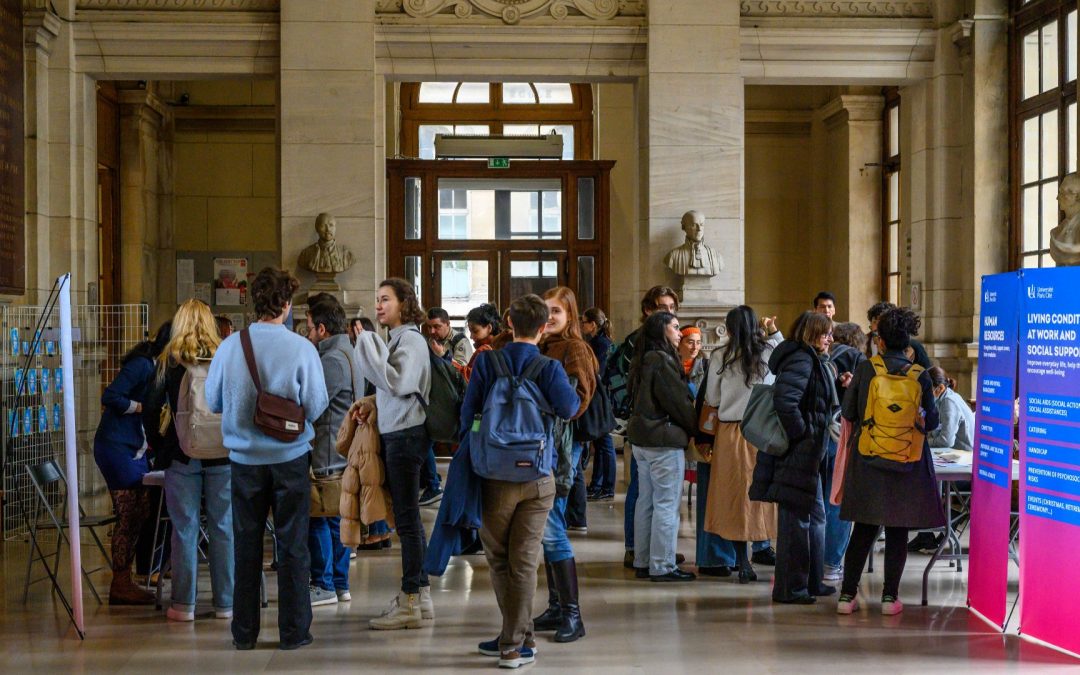By applying cutting-edge microscopy techniques to in vitro virus cultures, teams at the Institut Pasteur, CNRS, Vaccine Research Institute (VRI) and Université Paris Cité have discovered a new function of anti-HIV-1[1] antibodies. The scientists found that certain antibodies already known for effectively targeting HIV-1 envelope (Env) protein can prevent infected cells from releasing viral particles, thus halting viral spread. The antibodies are Y-shaped, enabling them to attach themselves between the infected cell and viral particles or directly between viral particles. This chain composed of antibodies and viral particles prevents viral spread. These findings demonstrate that these powerful antibodies exhibit different antiviral activities in addition to neutralization. The study is published in the February 2, 2022 issue of Nature Communications.

HIV particles (yellow) accumulate on the surface of an infected cell (purple). Image obtained by scanning electron microscopy and then stained.
© Stéphane Fremont, Jérémy Dufloo, Arnaud Echard, Timothée Bruel, Olivier Schwartz, Jean-Marc Panaud, Institut Pasteur.
Broadly neutralizing antibodies (bNAbs) targeting virus envelope (Env) protein have significant potential for treating HIV-1. They were initially identified in rare cases of patients whose serum was capable of inhibiting numerous HIV strains. These antibodies exhibit multiple antiviral activities. As well as neutralizing the virus, i.e. preventing it from infecting new cells, they also kill infected cells. Consequently, they are referred to as polyfunctional molecules. It is necessary to fully understand the scope of these antiviral activities in order to use existing antibodies more effectively or refine the selection criteria for new antibodies. It is moreover useful to further investigate the polyfunctionality of anti-HIV-1 antibodies in order to improve our understanding of the role played by antibodies and thus tackle other viral infections.
Initially, teams at the Institut Pasteur, CNRS, VRI and Université Paris Cité sought to determine whether antibodies were capable of preventing infected cells from producing viral particles. To that end, they cultured CD4 T cells (HIV’s natural target) in vitro with various antibodies for 24 hours. They subsequently measured the quantity of viral particles produced by the cells in the culture medium and the quantity of viral particles remaining in the cells. As a result of these experiments, the scientists were able to demonstrate that certain antibodies increased virus quantity in cells but reduced it in the culture medium. This intriguing finding led them to believe that certain antibodies impeded the release of viral particles without preventing their production.
To test this theory, the scientists used various microscopy techniques to observe cells’ production of viral particles. They initially examined the cells by fluorescence microscopy, a technique used to differentiate virus proteins. This enabled them to demonstrate that infected cells accumulate large quantities of mature viral protein. This finding suggests that full viral particles accumulate in cells. To determine the precise location of these viral particles, the scientists subsequently used scanning electron microscopy to observe the surface of infected cells. “Using this method, we observed that these antibodies (bNAbs) prompt an accumulation of viral particles at the surface of cells, forming clusters and highly atypical structures (see illustration),” comments Timothée Bruel, co-last author of the study and scientist in the Virus and Immunity Unit[2] at the Institut Pasteur.
Next, the scientists combined a transmission electron microscopy technique with immunogold labeling. This enabled them to demonstrate that antibodies interpose themselves between viral particles and the infected cell, forming a chain cluster. Experiments with mutant antibodies subsequently demonstrated that the antibodies’ Y shape creates this clustered structure. Their arms are capable of linking two viruses, or one virus to the infected cell membrane, and their attachment points are sufficiently strong to prompt this phenomenon.
“We have demonstrated that only the most powerful antibodies tether viral particles at the surface of infected cells. Trapped viral particles can no longer infect new cells,” concludes Olivier Schwartz, co-last author of the study and Head of the Virus and Immunity Unit at the Institut Pasteur.
This work has revealed a new antiviral activity for broadly neutralizing anti-HIV-1 antibodies. It deepens our understanding of these antibodies’ mechanism of action and explains their efficacy in clinical trials. The scientists are now examining antibodies targeting other viruses, including SARS-CoV-2, to determine whether they also inhibit viral spread through this mechanism.
(1) HIV-1 is the pandemic form of the human immunodeficiency virus. The other less common type is HIV-2.
(2) This is named the “Virology Unit” at the CNRS (CNRS/Institut Pasteur).
Source
Broadly neutralizing anti-HIV-1 antibodies tether viral particles at the surface of infected cells – Jérémy Dufloo1,2, Cyril Planchais3, Stéphane Frémont4, Valérie Lorin3, Florence Guivel-Benhassine1, Karl Stefic5, Nicoletta Casartelli1, Arnaud Echard4, Philippe Roingeard6, Hugo Mouquet3, Olivier Schwartz1,7,* and Timothée Bruel1,7,*
Read more
![[Cardiovascular Sciences] “Open UE”: looking back on an interdisciplinary adventure!](https://u-pariscite.fr/wp-content/uploads/2025/12/Sans-titre-1920-x-1080-px58-1080x675.jpg)
[Cardiovascular Sciences] “Open UE”: looking back on an interdisciplinary adventure!
The “open UE”, launched by the Graduate School Cardiovascular Sciences, brought together researchers, clinicians, and experts from diverse fields for a week to explore major issues in biomedical and translational research. Open to all students across the 29 Graduate Schools of Université Paris Cité, it offered a unique space for learning and interdisciplinary exchange.

Scientific event: the Neuroscience Graduate School highlights its young researchers
The Neuroscience Graduate School held the third edition of its scientific event, giving students from across the Graduate School the opportunity to present their research work. This now-established meeting has become a key moment for bringing together Master’s...

Call for applications for US Visiting Faculty 2026-2027
Committed to supporting research at the highest level through their partnership, Université Paris Cité and Sciences Po are calling for outstanding applications for visiting faculty from the United States. Apply before January 30, 2026.Candidates selected under a...

Université Paris Cité welcomed new international staff members
On November 14th, Université Paris Cité welcomed nearly 50 new international staff members – visiting lecturers, doctoral and post-doctoral students, researchers, and contractual lecturer-researchers of foreign nationality – who have arrived since the beginning of...
